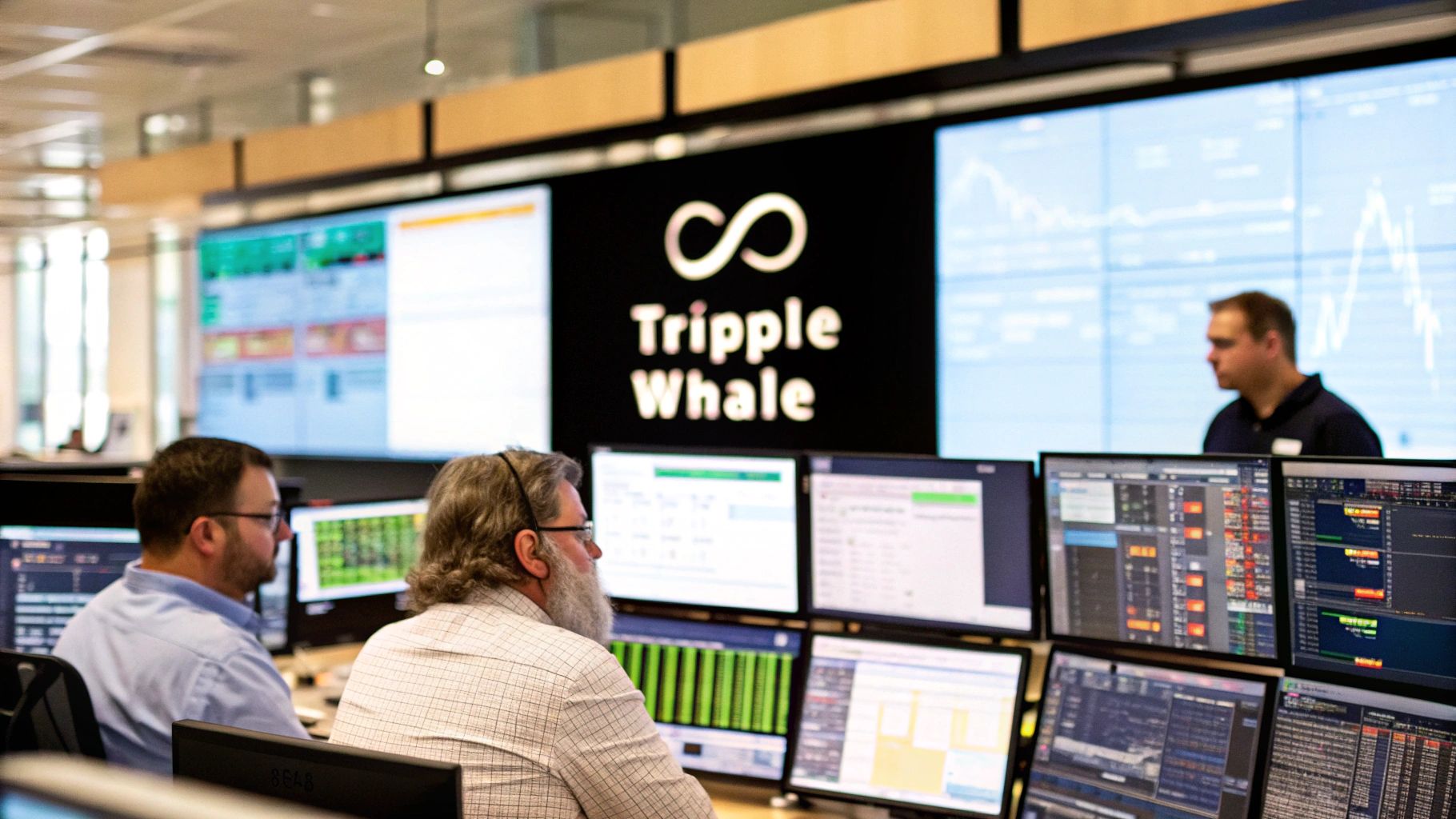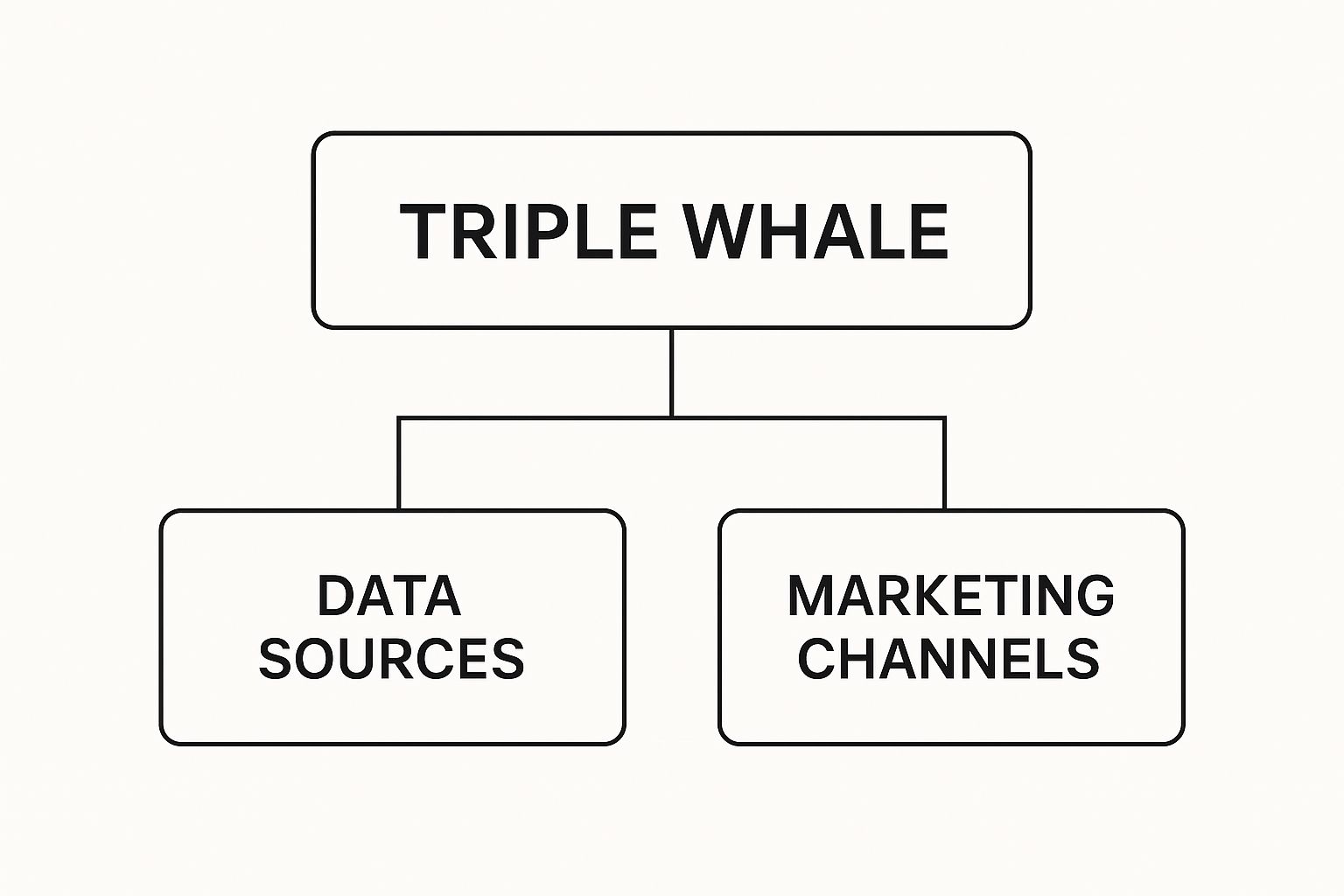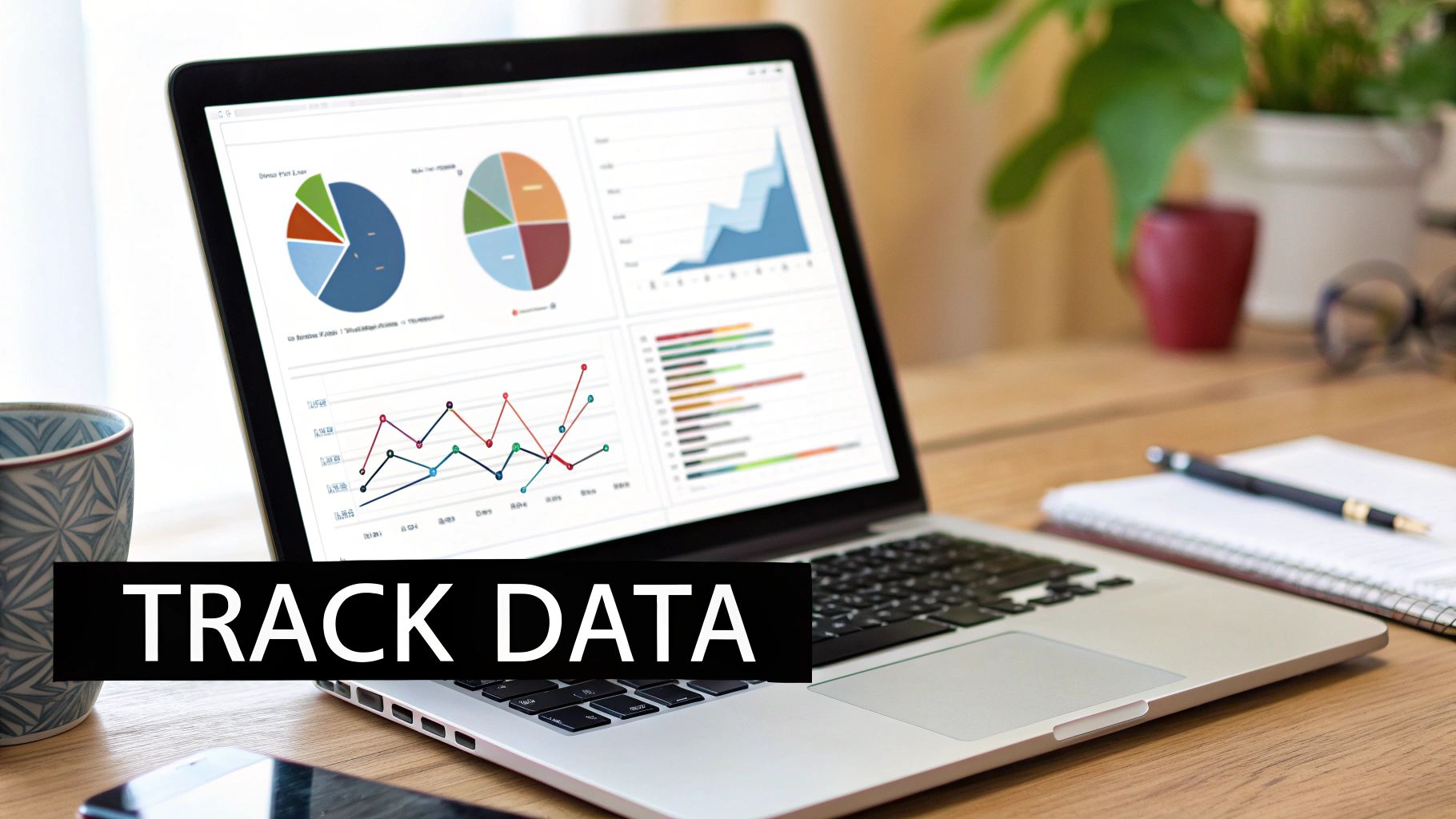Stay Updated with Everything about MDS
Thank you! Your submission has been received!
Oops! Something went wrong while submitting the form.

Chilat Doina
July 24, 2025
If you’ve ever found yourself drowning in a sea of spreadsheets, trying to stitch together data from Shopify, Facebook, Google, and TikTok, you know the headache. You're trying to answer a simple question—"Is this ad campaign actually making me money?"—but the answer is buried under layers of disconnected reports.
This is exactly the chaos Triple Whale was designed to eliminate.
Think of it less as just another analytics tool and more as the central nervous system for your entire e-commerce operation. It pulls all your critical data into one place, giving you a single, unified view of your business's health in real-time. No more exporting CSVs. No more guesswork. Just clarity.
This diagram really nails what Triple Whale does. It sits at the center, acting as a hub that pulls in all the signals from your different marketing channels and data sources.

It’s all about turning that tangled mess of data streams into a coherent, actionable picture of your brand's performance.
At its core, Triple Whale is about giving control back to founders. The platform’s mission is to be the single source of truth for every piece of data that matters to your brand. This allows you to stop guessing and start making sharp, profitable decisions based on what's actually happening.
By providing a clear, holistic view of performance, Triple Whale moves brands from reactive problem-solving to proactive, data-driven strategy. It shifts the focus from just gathering data to actually using it for growth.
The real-world impact is huge. We've seen mid-sized Shopify stores reclaim over 10 hours a week just by cutting out manual reporting. That's over 500 hours a year they get back to focus on building their business, not wrestling with spreadsheets. For a deeper dive, you can find a comprehensive review of Triple Whale and its impact on DropCowboy.com.
Triple Whale plugs directly into the tools you already rely on every day, creating a seamless information pipeline. It then organizes all that raw data into dashboards and reports that actually make sense.
Here’s a quick look at what it unifies:
To make it even clearer, here’s a breakdown of the core features and the specific problems they solve for e-commerce brands.
These features work together to create a comprehensive operating system that connects your marketing efforts directly to your bottom line.

Jumping into any new platform can feel like a lot, but Triple Whale does a great job of laying out its most powerful tools in a clean, functional dashboard. It’s built to give you answers right away, not just more questions. Let's walk through the core features you’ll find yourself using every day to actually move the needle.
The Summary Page is your five-minute morning coffee check-in. It's the first thing you see when you log in, and it gives you a complete, real-time snapshot of your store's health. You can finally stop opening ten different browser tabs to get your numbers. This page pulls all your vitals—net profit, ad spend, ROAS, and more—into one single screen.
For instance, you can glance at yesterday’s blended ROAS across every channel, check your actual net profit after COGS and shipping are factored in, and immediately spot any weird spikes or dips in performance. This daily pulse check sets you up to start your day knowing exactly where your business stands.
One of the features that gets the most buzz in the Triple Whale ecosystem is its pixel. And for good reason. In a post-iOS 14 world where tracking has become a nightmare, just relying on the native pixels from platforms like Facebook is a recipe for incomplete and misleading data.
The Triple Whale Pixel is a first-party, server-side pixel that you own. Think of it as your own private investigator living on your website, tracking every single customer interaction from their first click all the way to the final purchase. This gives you a much more honest and complete view of the customer journey, helping you see which ads are truly driving your sales.
By combining data from its own pixel with information from your ad platforms and Shopify, Triple Whale creates a hybrid attribution model. This blended approach provides a more reliable source of truth, allowing you to confidently allocate your budget to the campaigns that actually work.
What this means is you can finally get solid answers to questions like, "Did that TikTok video or that Google search ad really lead to the sale?" The pixel gives you the data to connect those dots with confidence.
Knowing which channel is working is one piece of the puzzle. But knowing which specific ad creative is resonating with your audience? That’s how you scale. This is exactly what the Creative Cockpit is for. It pulls every ad creative you're running—every image, video, and line of copy—from all your platforms into one easy-to-digest dashboard.
Here, you can compare the performance of your different ad assets side-by-side. The cockpit shows you the metrics that matter:
This lets you quickly spot the winning ads to scale up and the losers to shut off, making your ad spend incredibly precise. The platform’s Live Orders feature even shows purchases as they happen in real time, giving you instant feedback on your campaigns. One beauty brand I know used this feature during a launch to shift ad spend on the fly, and they ended up with a 40% higher conversion rate than on any previous launch. If you want to see more real-world examples, you can explore detailed insights on DropCowboy.com.
Once you've got a handle on daily performance, it’s time to dig deeper. The real competitive advantage in e-commerce doesn't come from just tracking day-to-day sales—it comes from understanding long-term trends and customer behavior. This is where the advanced analytics inside Triple Whale really separate the leading brands from the rest of the pack, especially with two game-changing tools: LTV Cohorts and Trends.
Think of it like this: a daily sales report is a single snapshot. LTV Cohorts, on the other hand, are like a time-lapse video. Instead of just seeing that a customer bought something today, you see how much value that same customer brings to your business over 60, 90, or even 120 days.
This perspective is crucial for judging the true success of your marketing. A campaign might have a weak ROAS on day one but attract customers who come back and make repeat purchases for months. LTV Cohorts uncover this hidden value, helping you make smarter budget decisions based on long-term profitability, not just immediate returns.
Beyond looking at your own data, how do you know if your performance is actually any good? A 2.0 ROAS might feel disappointing, but what if every other brand in your niche is only hitting 1.5? Context is everything, and that’s exactly what the Trends feature provides.
Trends is a powerful benchmarking tool that gives you an unprecedented look at your industry's performance. It aggregates anonymized data from thousands of other e-commerce stores on the platform, letting you compare your key metrics against your direct competitors. You can see how your ROAS, CPA, and CPC stack up against other skincare brands, for example, not just some generic e-commerce average.
This allows you to set realistic goals and diagnose problems with incredible precision. If your ROAS suddenly drops, you can instantly check Trends to see if it’s a market-wide slump or something specific to your own campaigns. This kind of competitive intelligence helps you navigate market shifts with confidence. To learn more about how to scale your business using advanced analytics, you might be interested in our guide on driving sales with AI and advanced analytics.
The power of Trends is its specificity. It moves you from comparing your results to a vague "industry average" to benchmarking against a curated group of your closest peers, providing true context for your performance metrics.
For example, the screenshot below illustrates how Trends breaks down metrics like ROAS across different advertising platforms for a specific industry.
This visual shows that performance can vary dramatically between channels like Facebook and Google, giving you a clear benchmark for what's actually achievable in your market. This level of detail is powered by a massive dataset. Triple Whale’s Trends tool aggregates anonymized data from over 11,000 global customers, offering a rich source of competitive insights. While the median ROAS across all brands was 2.04, this figure changes significantly when filtered by industry, as you can learn more about industry benchmarks on TripleWhale.com.

Any analytics platform is only as good as the tools it talks to. This is where a Triple Whale setup really shines—it’s not just another dashboard you have to check. It’s designed to be the central nervous system for a modern e-commerce tech stack, built from the ground up to tear down the walls between your most critical platforms.
It doesn’t just passively collect data from your ad channels. It actively creates a unified ecosystem where every piece of your marketing puzzle actually fits together. This connectivity is the secret sauce to getting that single, reliable source of truth every founder dreams of.
Triple Whale plugs right into the tools you’re already using every single day, creating a cohesive environment that finally gives you the complete picture.
Triple Whale’s power comes from its direct, one-click integrations with the absolute pillars of e-commerce marketing. This approach gets rid of the soul-crushing, time-sucking task of manually exporting CSVs and trying to stitch together reports from a half-dozen different sources.
Here are some of the most important connections it makes:
This level of deep integration uncovers connections you’d otherwise completely miss. For instance, you can see exactly how a particular Klaviyo welcome series contributes to your customer LTV, right next to the performance of your latest Facebook campaign. That cross-channel view is what lets you make smart, holistic decisions instead of just optimizing in a vacuum.
If you want to dive deeper, you can check out our guide on the importance of a well-connected setup and learn more about effective e-commerce platform integration.
By unifying all these different data sources, Triple Whale helps you figure out what’s a market-wide trend versus what’s a problem unique to your brand’s operations. This is where its benchmarking features become insanely powerful, offering a level of context that used to be inaccessible for most small and medium-sized businesses.
With apples-to-apples comparisons, Triple Whale allows a brand to see if a performance dip is due to a market-wide trend or an internal strategy that needs adjustment.
Let’s say you run a children’s toy store. You can log in, look at your ROAS, and immediately see how it stacks up against the aggregated, anonymous performance of every other toy brand using the platform. That’s a depth of competitive intelligence that completely changes how you read your own numbers. You can discover more insights about these benchmarking features on TripleWhale.com.
This whole approach ensures you’re not just staring at data points—you’re actually understanding your place in the wider market.
Picking a new platform can feel like a huge commitment, but choosing the right Triple Whale plan doesn't have to be a headache. The trick is to line up a plan’s features with where your business is right now and what you're spending on ads. Think of it less like a binding contract and more like grabbing the right tool for the job.
The pricing is built to grow with you. A store just getting its sea legs and starting to experiment with ad spend has totally different needs than an eight-figure brand juggling complex campaigns across a dozen channels. Triple Whale gets this, and its plans are set up so you’re only paying for the tools that will actually move the needle for you today.
Triple Whale lays out a few main pricing tiers, and each one is designed for a different level of business maturity. The entry-level plan, usually just called "Triple Whale," is a perfect starting point for brands that are scaling up and need to finally get a real handle on their attribution and profitability. It gives you the essentials, like the Summary Page and the Pixel.
As your ad spend climbs and your team expands, you’ll find yourself needing much deeper analytics. That's where the higher-tier plans like "Triple Whale + Attributed" come in. These are built for brands spending serious cash on ads, often north of $50,000 a month. These plans unlock the heavy-duty features that give you a clearer picture of long-term customer value and which ad creatives are really working.
The real difference between the plans isn’t just about getting more features—it’s about the depth of the insights. Higher tiers are for businesses where a 10% bump in ROAS translates to tens of thousands of dollars in pure profit, making the investment a no-brainer.
One of the smartest things about Triple Whale’s pricing is the Whale Credit system. Instead of being strong-armed into a pricier plan for one or two premium features you’re eyeing, Whale Credits give you flexibility. You can buy these credits to unlock specific add-ons à la carte, like advanced creative reporting or LTV cohort analysis.
This lets you patch together a custom plan that perfectly fits your current focus without paying for a bunch of stuff you don't need yet. For instance, if your main goal this quarter is to dial in your influencer marketing ROI, you can just use credits to turn on the Affluencer Hub without upgrading your whole subscription. It's all about paying for the value you're actually getting, not for a bloated bundle of features.

Alright, we’ve covered a lot of ground. After digging into all its features, the big question is still on the table: is Triple Whale the right move for your business right now?
Honestly, the answer is different for everyone. It really boils down to where you are on your growth journey and what specific headaches you're trying to get rid of. Making the right call means taking a hard, honest look at what your brand actually needs.
If you’re a direct-to-consumer brand, probably on Shopify, and you're actively pouring money into paid ads, you're in the right ballpark. For founders managing budgets across Facebook, Google, and TikTok who feel like they’re drowning in attribution chaos—this tool was practically built for you. It's for the entrepreneur who's ready to look past simple revenue numbers and get a real grip on true net profitability.
Triple Whale really shines when it’s in the hands of a business that fits a certain profile. You’ll see the best return on your investment if your brand:
On the flip side, if you're just dipping your toes in the water with minimal ad spend, the platform might be overkill for now.
The real value of Triple Whale clicks into place when the cost of not having clear data—wasted ad spend, missed opportunities, and slow decisions—becomes more expensive than the subscription itself.
Ultimately, the choice comes down to a pretty simple trade-off. By pulling all your data into one place, giving you clear attribution, and showing you how you stack up against the competition, Triple Whale offers a direct line to smarter growth. For any brand that's serious about scaling, understanding how to grow an ecommerce business means investing in tools that deliver exactly this kind of clarity.
Alright, let's tackle those burning questions you probably have about Triple Whale. When you're looking at a new tool, you just want the straight answers, so here’s what you need to know.
This is a big one. The Triple Whale Pixel isn't just another tracking script; it's a first-party, server-side pixel that you own. Think of it as your in-house data collector, capturing everything that happens across your entire site.
In contrast, something like the Facebook Pixel is a third-party tool that lives and breathes inside Facebook's world. The Triple Whale pixel gives you a much more complete and accurate picture of the whole customer journey, from first click to final purchase.
This holistic approach is designed to overcome the tracking gaps created by iOS updates and ad blockers, providing more reliable attribution data to guide your marketing spend.
For most e-commerce founders? Absolutely. Triple Whale was built from the ground up to be an operating system for e-commerce, with a laser focus on the profitability metrics that actually matter. This makes its dashboard far more intuitive for the day-to-day decisions you have to make.
While some die-hard marketers might hang onto Google Analytics for super deep-dive web traffic analysis, we see most founders quickly adopt Triple Whale as their one-and-only source of truth for performance and marketing attribution. It just makes more sense for running a business.
Honestly, the setup is surprisingly painless. It was clearly designed with non-technical founders in mind.
The onboarding process is a simple, guided flow. It walks you through connecting your Shopify store, linking your ad accounts like Facebook and Google, and installing the Triple Whale pixel. Most brands are fully up and running in under an hour, and you won't have to write a single line of code.
At Million Dollar Sellers, we know that having the right data is a non-negotiable part of scaling to 7, 8, and 9 figures. For more insights on building a high-growth e-commerce brand, check out our exclusive community at https://milliondollarsellers.com.
Join the Ecom Entrepreneur Community for Vetted 7-9 Figure Ecommerce Founders
Learn MoreYou may also like:
Learn more about our special events!
Check Events